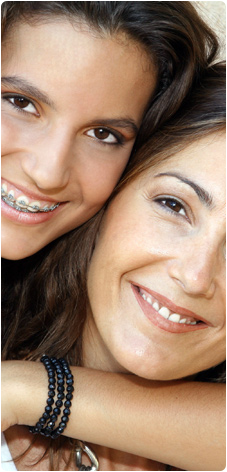
Orthodontic Appliance Care
Check your braces once a week for anything loose or bent. If a bracket or band comes loose or you break a wire, please call our office so we can arrange an appointment long enough to repair it. Even if your appointment is the same day or the next day, please call our office so that we can be prepared for the additional work that will be needed to repair anything that is broken or loose..
Elastics (Rubber Bands)
Elastics move the teeth in a direction that cannot be accomplished with braces alone. Your teeth and jaws may be tender the first few days of wearing the elastics. This is normal and should begin to disappear within a week.
Attaching your elastics may seem hard initially; however, with a little time and patience, you will be able to accomplish your task easily. Elastic wear must be constant to be effective, 24 hours a day - 7 days a week, unless otherwise indicated. Any time missed in wearing your elastics will only prolong your treatment, so make sure to wear them as instructed. You may remove the elastics only when eating meals or brushing your teeth. Be sure to replace the elastics with new ones immediately following mealtime and brushing. Part-time wear does NOT move teeth, but part-time wear will cause the teeth to be constantly sore.
Change the elastics routinely even if they are not broken. After a while, elastics will lose their strength. Change them at least after each meal and before bedtime. If one elastic breaks, replace both sides.
Carry extra elastics with you at all times. If you don’t have enough elastics to last until your next appointment, please stop by our office and pick some more up. We don’t want you to run out.
Elastic wear is an important key to the speed of your treatment and the final results we can achieve. Please call us if you have any questions or concerns.
Quad Helix
A Quad Helix is for patients whose upper back teeth, whether it is on one side or both sides, are narrower than the lower teeth. This appliance is custom made for each patient. It gently helps widen the upper teeth so that they fit better with the lower teeth. The Quad Helix is most often used for young patients who do not have all of their adult teeth.
The Quad Helix is checked and expanded approximately once every four to six weeks. After the expansion is complete, the Quad Helix will remain in the mouth until the expansion is stable.
Patients may feel mild discomfort for a couple of days. The tongue and cheeks have to make adjustments to the new appliance. Speaking and eating will require patience and time getting used to your appliance. Avoid hard foods and sticky foods. You will be able to clean your teeth and the appliance with your regular toothbrush.
RPE (Rapid Palatal Expansion)
Rapid Palatal Expansion [RPE] is for patients whose upper jaw is narrow. Your RPE gently widens the upper arch [palate] by stretching the center palatal suture. Once widened, the suture knits together. A parent or the patient adjusts the RPE daily as instructed, until the upper jaw has been widened enough.Before the RPE feels comfortable, the patient may sense some initial pressure and expect:
- To feel a tingling or itch under the expander
- To feel a tingling sensation across the bridge of the nose
- To feel pressure in the cheek area
- To see a space appear between the upper two front teeth
- A hunger sensation
- Impaired speech, initially reading a book out loud will help
A special key is used to activate the RPE:
- Insert the key into the key slot; the key is bent, therefore it will not touch the roof of the mouth
- Push the key all the way from the front to the back. Look for the next hole to rotate forward enough so you will be able to place the key into the next hole to turn your RPE
Remember when brushing:
- Use an interproximal brush and a regular toothbrush
- Brush as usual
- A Waterpik is helpful to dislodge food that gets caught in the expander
Separators
Separators (Spacers) are usually placed between the molars one to two weeks prior to fitting the braces or appliances. The separators may cause slight discomfort for a few hours or a few days. They gently wedge the back teeth apart to make it easier to cement the bands that will be placed on the molars. Do not eat any sticky or chewy foods. Do not play with the separators with your tongue. Do not grind your teeth across the separators. Do not floss between the teeth that have the separators. Unless your appointment is the following day, please call our office if any of the separators fall out before your next appointment.
Athletic Mouthguard
The AAO found that the majority of children do not wear mouthguards while playing organized sports because they are not required to wear them, even though they may be required to wear other protective materials, such as helmets and shoulder pads. Mouthguards can be one of the least expensive pieces of protective equipment available. Not only do mouthguards save teeth, they help protect jaws. Children wearing braces have slightly higher risk of oral injuries, including mouth lacerations, if their braces are hit by a ball or another player. In fact, just by wearing a properly fitted mouthguard, many accidents and traumatic injuries could be prevented. The American Dental Association estimates that mouthguards prevent more than 200,000 oral injuries each year.
Who Needs a Mouthguard?
Mouthguards should be used by anyone — both children and adults — who play contact sports such as football, baseball, wrestling, volleyball, boxing, soccer, ice hockey, basketball, lacrosse, and field hockey. However, even those participating in noncontact sports (for example, gymnastics) and any recreational activity (for example, skateboarding, mountain biking) that might pose a risk of injury to the mouth would benefit from wearing a protective mouthguard.
Choosing a Mouthguard
While custom mouthguards, considered by many to be the most protective option, other mouthguards can be effective if they fit well, are worn properly and stay in place.
Athletic mouthguards provide protection, but vary in comfort and cost. The most effective mouthguard should be resilient, tear-resistant and comfortable. It should fit properly, be durable and easy to clean, and not restrict your speech or breathing. Generally, a mouthguard covers only the upper teeth, but in some cases with orthodontics you may need a mouthguard for the lower teeth as well. Patients can bring their mouthguards to our office to allow us to help ensure proper fit and adequate protection in critical areas.
Like any other sports gear, a mouthguard will wear out, making it less effective. If your mouthguard has holes or tears, or if it becomes loose, it can irritate the teeth and oral tissues. Occasionally check the mouthguard’s condition and replace it as necessary.
















NEWNAN GA 30263